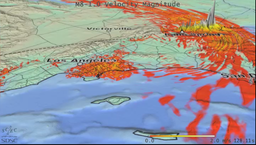Difference between revisions of "M8"
From SCECpedia
Jump to navigationJump to search| Line 6: | Line 6: | ||
#M8 simulation computational scale has a combined outer/inner scale of 10 ^ 4.3 (810km/40m) | #M8 simulation computational scale has a combined outer/inner scale of 10 ^ 4.3 (810km/40m) | ||
#M8 science run using SCEC's AWP-ODC software achieved sustained performance on real science problem for 24 hours in excess of 220Tflop/s. When the M8 simulation was run in April, 2010, no other seismic code had achieved more than 100Tflop/s. | #M8 science run using SCEC's AWP-ODC software achieved sustained performance on real science problem for 24 hours in excess of 220Tflop/s. When the M8 simulation was run in April, 2010, no other seismic code had achieved more than 100Tflop/s. | ||
| − | #M8 | + | #M8 wave propagation simulation run on NCCS Jaguar used more cores (220,000) and processors (xxxx). No other seismic wave propgation application has be used to do real science runs using more cores than M8. |
#The M8 simulation software, SCEC's AWP-ODC, scaled nearly perfectly up to 223k cores | #The M8 simulation software, SCEC's AWP-ODC, scaled nearly perfectly up to 223k cores | ||
#M8's input velocity mesh required 435 billion grid points. We are not aware of any simulations at this size. | #M8's input velocity mesh required 435 billion grid points. We are not aware of any simulations at this size. | ||
Revision as of 04:04, 17 September 2010
SCEC M8 Simulation
The SCEC M8 Simulation involved a very large dynamic rupture, run on NICS Kraken in March, 2010, and a very large and earthquake wave propagation simulation, performed on NICS Jaguar in April 2010. M8 can be described as the largest earthquake wave propagation simulation for following reasons:
- M8 simulation computational scale has a combined outer/inner scale of 10 ^ 4.3 (810km/40m)
- M8 science run using SCEC's AWP-ODC software achieved sustained performance on real science problem for 24 hours in excess of 220Tflop/s. When the M8 simulation was run in April, 2010, no other seismic code had achieved more than 100Tflop/s.
- M8 wave propagation simulation run on NCCS Jaguar used more cores (220,000) and processors (xxxx). No other seismic wave propgation application has be used to do real science runs using more cores than M8.
- The M8 simulation software, SCEC's AWP-ODC, scaled nearly perfectly up to 223k cores
- M8's input velocity mesh required 435 billion grid points. We are not aware of any simulations at this size.
The M8 Project is lead by Yifeng Cui, Kim Olsen, and Thomas H. Jordan.
SCEC and CME-related Web Sites
- PetaSHA3 Project
- SCEC/CME Project Page
- Public CME Website
- Public SCEC Wiki
- SCEC Web Site
- CSEP
- SCEC M8
- CME Movies and Animations
- CVM-Toolkit
- SCEC Websims Data Management Site
- SCEC CSEP Testing Center
SCEC Computer Science Collaborative Organizations and Resource Providers
- SDSC
- SDSC HPGeoC
- SDSC Visualization Services
- Scientific Workflows at USC/ISI
- Fault Tolerant Computing at CSM
- USC HPCC
- PSC
- NICS
- NCCS
- TACC
- NCSA
- Blue Waters
- Open Science Grid
CME-related 2010 SCEC Annual Meeting Posters:
